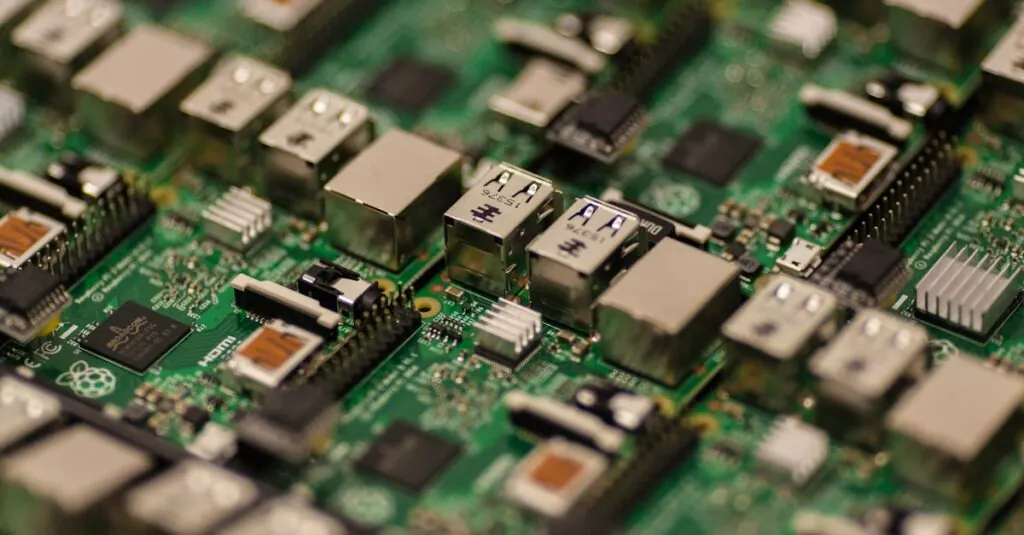Table of Contents
ToggleWhen it comes to boosting a computer’s performance, RAM speed ratings are the unsung heroes of the tech world. Think of them as the caffeine shot for your machine—without it, things can get sluggish faster than a tortoise in a marathon. Whether you’re gaming, editing videos, or just trying to keep up with your cat meme obsession, understanding these ratings can make all the difference.
Understanding RAM Speed Ratings
RAM speed ratings represent the data transfer rate of random-access memory. This measurement significantly influences a computer’s overall performance.
What Are RAM Speed Ratings?
RAM speed ratings indicate how quickly memory can read and write data. Expressed in megahertz (MHz), these ratings show the frequency at which RAM operates. For instance, 2400 MHz RAM can transfer data 2.4 billion times per second. These numbers help consumers identify suitable memory modules for their systems. Higher RAM speeds lead to faster data processing, improving task efficiency.
Importance of RAM Speed Ratings
RAM speed ratings hold substantial importance for performance enhancement. Faster RAM reduces latency, leading to quicker load times and smoother multitasking. Tasks demanding high bandwidth, such as gaming and content creation, benefit from higher speed ratings. Inadequate RAM speed can lead to bottlenecks, stalling system response. Memory modules with optimal speed ratings offer better responsiveness and fluid user experience.
How RAM Speed Ratings Are Measured
RAM speed ratings measure how quickly data transfers within memory. These ratings are essential for understanding performance impact on tasks like gaming and video editing.
Different Metrics in Speed Ratings
Various metrics define RAM speed ratings. Megahertz (MHz) reflects the frequency at which the RAM operates, indicating the number of cycles per second. CAS latency measures the delay before the RAM responds to a request, which affects overall performance. Combining these metrics provides a clearer picture of RAM capabilities. Some users prioritize MHz for gaming, while others focus on CAS latency for critical applications. Knowing how these metrics interact can help identify the right RAM for specific needs.
Comparison of DDR Types
Different DDR types influence RAM speed significantly. DDR4 typically operates between 1600 MHz and 3200 MHz, offering enhanced efficiency over its predecessors. DDR5, on the other hand, starts at 4800 MHz, providing double the data rate of DDR4. As newer generations appear, they push the boundaries of speed and performance. Compatibility with a motherboard dictates which DDR type can be used, so verifying specifications is crucial. Understanding the differences in these generations can aid in selecting the best RAM for any system.
Impact of RAM Speed Ratings on Performance
RAM speed ratings significantly affect overall computing performance. Faster RAM improves data processing speed, leading to enhanced user experiences in various applications.
Gaming Performance
High RAM speed ratings benefit gaming experiences. Increased MHz reduces latency, allowing games to load more quickly. Gamers notice smoother frame rates and improved responsiveness during intense gameplay. Memory modules with higher speeds enable faster texture loading and reduce stuttering in graphics-heavy games. Many gaming setups prioritize RAM speed alongside graphics card specifications to maximize performance.
Productivity and Multitasking
RAM speed ratings enhance productivity and multitasking capabilities. Users engaged in tasks like video editing or graphic design benefit from faster data handling. Systems equipped with high-speed RAM can process large files seamlessly, minimizing lag during complex operations. Faster memory also allows for efficient multitasking, letting users run multiple applications without significant slowdowns. Professionals relying on software that demands high bandwidth often prioritize selecting RAM with higher speed ratings to ensure optimal efficiency.
Choosing the Right RAM Speed Rating
Selecting the appropriate RAM speed rating enhances performance and meets specific user needs. Understanding how different users engage with their systems helps in determining optimal RAM specifications.
User Needs and Use Cases
Gamers typically require faster RAM to improve frame rates and reduce latency. Content creators often seek efficient memory for multitasking and handling large files seamlessly. Data analysis professionals benefit from speed ratings that enhance processing speed during complicated calculations. Casual users can prioritize cost over speed, as basic tasks don’t demand high-speed RAM. By aligning RAM choices with specific use cases, users can optimize system performance effectively.
Compatibility Considerations
Compatibility between RAM and motherboard is crucial for optimal functioning. Different motherboards support various RAM types, such as DDR4 and DDR5, with distinct speed ratings. Users should check their motherboard specifications, including maximum supported speeds and capacity limits. Investigating architecture differences helps ensure seamless integration and performance. Slot availability is another factor, as not all motherboards can accommodate multiple RAM sticks. Understanding these compatibility factors guarantees that RAM choices align with the overall system configuration.
Conclusion
RAM speed ratings play a pivotal role in determining a computer’s overall performance. Users who prioritize high-speed RAM can expect smoother experiences whether they’re gaming or handling intensive tasks. By understanding the nuances of MHz and CAS latency, individuals can make informed decisions tailored to their specific needs.
Selecting the right RAM isn’t just about speed; it’s also about ensuring compatibility with the motherboard. This alignment guarantees that users can maximize their system’s potential. Ultimately, investing time in understanding RAM speed ratings can lead to significant enhancements in productivity and enjoyment across various applications.




